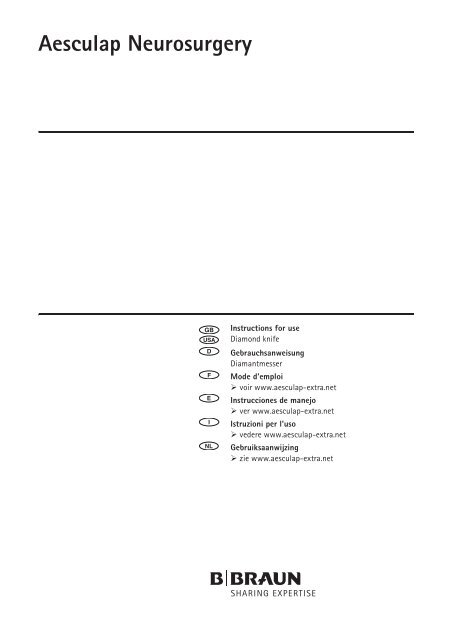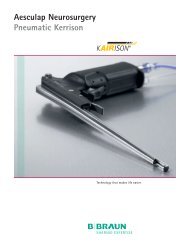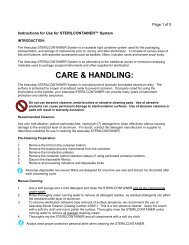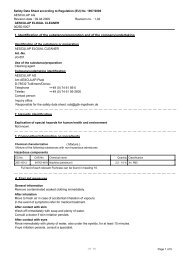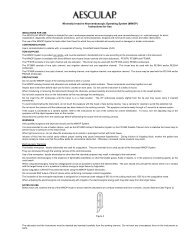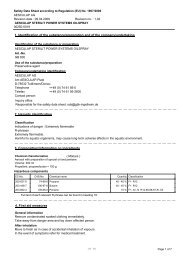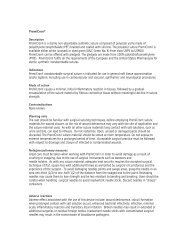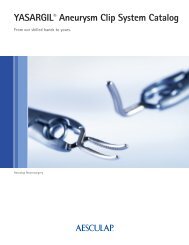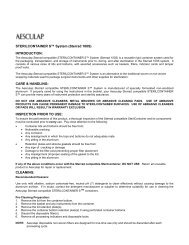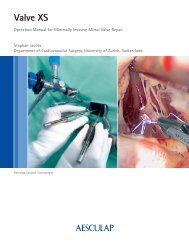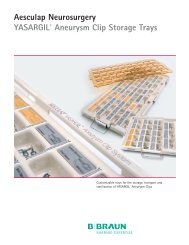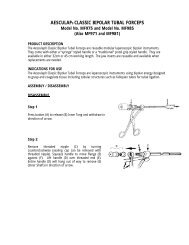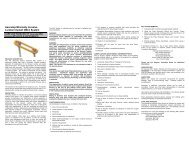Aesculap Neurosurgery
Aesculap Neurosurgery
Aesculap Neurosurgery
Erfolgreiche ePaper selbst erstellen
Machen Sie aus Ihren PDF Publikationen ein blätterbares Flipbook mit unserer einzigartigen Google optimierten e-Paper Software.
<strong>Aesculap</strong> <strong>Neurosurgery</strong><br />
Instructions for use<br />
Diamond knife<br />
Gebrauchsanweisung<br />
Diamantmesser<br />
Mode d’emploi<br />
‣ voir www.aesculap-extra.net<br />
Instrucciones de manejo<br />
‣ ver www.aesculap-extra.net<br />
Istruzioni per l’uso<br />
‣ vedere www.aesculap-extra.net<br />
Gebruiksaanwijzing<br />
‣ zie www.aesculap-extra.net
1<br />
2<br />
3 4 5 6
<strong>Aesculap</strong> <strong>Neurosurgery</strong><br />
Diamond knife<br />
Legend<br />
1 Diamond knife (diamond blade retracted)<br />
2 Diamond knife (diamond blade extended)<br />
3 Diamond blade<br />
4 Sleeve<br />
5 Handle<br />
6 Activation sleeve with rinsing connector<br />
Symbols on product<br />
Intended use<br />
Attention, see instructions for use<br />
Diamond knives are used for general neurosurgical<br />
operations.<br />
The precise incisions achievable with these instruments<br />
is among the preconditions for application in<br />
delicate surgical interventions at the:<br />
• Arachnoid<br />
• Dura<br />
• Nerves<br />
Safe handling and preparation<br />
CAUTION<br />
Federal law restricts this device to sale by or on<br />
order of a physician!<br />
‣ Read, follow and keep the instructions for use.<br />
‣ Use the product only in accordance with its<br />
intended use, see Intended use.<br />
‣ Clean the new product either manually or mechanically<br />
prior to the initial sterilization.<br />
‣ Store any new or unused products in a dry, clean<br />
and safe place.<br />
‣ Prior to each use, inspect the product for: loose,<br />
bent, broken, cracked, worn, or fractured components.<br />
‣ Do not use the product if it is damaged or defective.<br />
Set aside the product if it is damaged.<br />
Safe operation<br />
WARNING<br />
Injury to the patient caused by<br />
chipping of the diamond blade!<br />
‣ Avoid contact of the delicate<br />
blades at tips with hard surfaces<br />
or other instruments.<br />
‣ Use the instrument only in<br />
accordance with its intended<br />
use.<br />
CAUTION<br />
Damage to the diamond blade!<br />
‣ Avoid contact of the delicate<br />
blades at tips with hard surfaces<br />
or other instruments.<br />
‣ Keep the diamond blade protected<br />
by the sleeve when the<br />
instrument is not in use.<br />
2
Extending the diamond blade from the sleeve<br />
‣ Unlock activation sleeve 6 by turning it in the<br />
direction of the arrow, see Fig. 1.<br />
‣ Lock activation sleeve 6 by turning it in the direction<br />
of the arrow, see Fig. 3.<br />
6<br />
6<br />
Fig. 1<br />
‣ Push activation sleeve 6 towards the instrument<br />
tip, see Fig. 2.<br />
6<br />
Fig. 3<br />
Diamond blade 3 is now extended and fixed.<br />
Retracting the diamond blade into the sleeve<br />
‣ Unlock activation sleeve 6 by rotating it.<br />
‣ Push activation sleeve 6 towards the instrument<br />
end.<br />
‣ Lock activation sleeve 6 by rotating it.<br />
Diamond blade 3 is now retracted and fixed.<br />
Fig. 2<br />
3
<strong>Aesculap</strong> <strong>Neurosurgery</strong><br />
Diamond knife<br />
Validated processing procedure<br />
Note<br />
Observe all relevant national regulations and standards<br />
with regard to processing.<br />
Note<br />
For patients with Creutzfeldt-Jakob disease (CJD),<br />
suspected CJD or possible variants of CJD, observe the<br />
relevant national regulations concerning the<br />
reprocessing of the products.<br />
Note<br />
Mechanical processing should be preferred over<br />
manual cleaning because of the better and more<br />
reliable cleaning results of mechanical processing.<br />
Note<br />
Successful processing of this medical product can only<br />
be ensured through a validated processing procedure.<br />
The user/processor is responsible for the validation.<br />
Due to process tolerances, manufacturer’s<br />
specifications can only serve as guide values for the<br />
processing procedures applied by the individual user.<br />
Note<br />
Up-to-date information on processing can be found on<br />
the <strong>Aesculap</strong> Extranet at www.aesculap-extra.net<br />
General notes<br />
Encrusted or fixated residues from surgery can make<br />
the cleaning process more difficult or ineffective, and<br />
can cause corrosion of “stainless” steels. Therefore the<br />
time interval between application and processing<br />
should not exceed 6 h, and neither fixating precleaning<br />
temperatures > 45 °C nor any fixating<br />
disinfecting agents (active ingredient: aldehyde,<br />
alcohol) should be used.<br />
Excessive doses of neutralizers or basic detergents can<br />
cause chemical degradation and/or fading of the laser<br />
engraving on stainless steel.<br />
Residues containing chlorine or chlorides, as contained<br />
e.g. in surgical residues, tinctures, medicines, saline<br />
solutions, servicewater used for cleaning and in<br />
cleaning/disinfecting agents, will cause corrosion<br />
damage (pitting, stress corrosion) and, consequently,<br />
destruction of stainless steel products. To remove such<br />
residues, the products must be rinsed sufficiently with<br />
fully desalinated water and dried thoroughly.<br />
Only use process chemicals recommended by the<br />
chemicals’ manufacturers as effective cleaning/<br />
disinfecting agents compatible with the materials used<br />
in the respective product. Strictly observe all<br />
application instructions, e.g. regarding temperatures,<br />
concentrations, exposure times, etc. Failure to do so<br />
can result in the following problems<br />
• Optical changes to the material, e.g. fading or<br />
discoloration of titanium or aluminum. For<br />
aluminum, the application/process solution only<br />
needs to be of pH > 8 to cause visible surface<br />
changes or<br />
• Material damage, e.g. corrosion, cracks, fracturing,<br />
premature aging or swelling.<br />
4
‣ Clean the product immediately after use.<br />
‣ Further detailed advice on hygienically safe and<br />
material-/value-preserving reprocessing can be<br />
found at www.a-k-i.org, link to Publications, Red<br />
Brochure – Proper maintenance of instruments.<br />
Preparations prior to cleaning<br />
‣ Have the product dry in a disposal container and<br />
ready for immediate cleaning and disinfecting<br />
within 30 min after use.<br />
Cleaning/Disinfecting<br />
WARNING<br />
Cut injuries due to touching of the<br />
diamond blade!<br />
‣ Do not touch the diamond<br />
blade.<br />
‣ Activate the sleeve when the<br />
instrument is not used.<br />
‣ Apply proper caution when<br />
handling or cleaning the<br />
instrument.<br />
CAUTION<br />
Damage to the product due to<br />
inappropriate cleaning/disinfecting<br />
agents and/or excessive<br />
temperatures!<br />
‣ Use cleaning and disinfecting<br />
agents approved for titanium<br />
and high-grade steel according<br />
to manufacturer’s instructions.<br />
‣ Observe specifications regarding<br />
concentration, temperature and<br />
exposure time.<br />
‣ Do not exceed the maximum<br />
allowable cleaning temperature<br />
of 55 °C.<br />
‣ If the microsurgical products can be securely fixed<br />
in machines or in storage devices in such a way<br />
that they will be thoroughly cleaned, clean and<br />
disinfect them mechanically.<br />
CAUTION<br />
Damage to the diamond blade!<br />
‣ Avoid contact of the delicate<br />
blades at tips with hard surfaces<br />
or other instruments.<br />
‣ Do not apply ultrasound<br />
treatment.<br />
‣ Do not carry out immersion<br />
disinfection.<br />
‣ Do not clean the diamond blade<br />
with cleaning brushes.<br />
‣ Process and store the product in<br />
an appropriate storage unit.<br />
Ensure that the product is<br />
securely fixed in the storage<br />
unit.<br />
5
<strong>Aesculap</strong> <strong>Neurosurgery</strong><br />
Diamond knife<br />
Manual cleaning/disinfecting<br />
‣ Extend the diamond blade from the sleeve and lock<br />
it in this position.<br />
‣ Check visible surface for residues after manual<br />
cleaning/disinfecting.<br />
‣ Repeat the cleaning process if necessary.<br />
Manual cleaning with disinfecting cleaning by wipe disinfection<br />
Stage<br />
Step<br />
T<br />
[°C/°F]<br />
t<br />
[min]<br />
Conc.<br />
[%]<br />
Water<br />
quality<br />
Chemical<br />
I Cleaning RT<br />
(cold)<br />
- - D–W -<br />
II<br />
Wipe<br />
disinfection<br />
- 1 - - Meliseptol HBV wipes<br />
30 % Propan-1-ol<br />
III Final rinse RT<br />
(cold)<br />
0.5 - FD–W -<br />
IV Drying RT - - - -<br />
D–W:<br />
FD–W:<br />
RT:<br />
Drinking water<br />
Fully desalinated water (demineralized)<br />
Room Temperature<br />
Stage I<br />
‣ Clean the product under running tap water, using<br />
a suitable cleaning brush if necessary, until all<br />
visible residues have been removed from the<br />
surface.<br />
‣ Do not clean the diamond blade with cleaning<br />
brushes.<br />
‣ Mobilize non-rigid components, e.g. set screws,<br />
links, etc. during cleaning.<br />
‣ To avoid the risk of corrosion, do not use a metal<br />
brush or other abrasives that would damage the<br />
surfaces for cleaning the product.<br />
Stage II<br />
‣ Wipe all surfaces of the product with a single-use<br />
cleaning wipe.<br />
‣ Clean the diamond blade with a single-use<br />
cleaning wipe, wiping over the blade towards the<br />
tip.<br />
Stage III<br />
‣ After the prescribed exposure time (1 minute),<br />
rinse the disinfected surfaces under running FD<br />
water.<br />
‣ Allow water to drip off for a sufficient length of<br />
time.<br />
6
Stage IV<br />
‣ Dry the product with a lint-free tissue.<br />
Mechanical cleaning/disinfecting<br />
‣ Retract the diamond blade into the sleeve and lock<br />
it in this position.<br />
‣ Place the product on a tray that is suitable for<br />
cleaning (avoid rinsing blind spots).<br />
‣ Connect the rinsing connector of the diamond<br />
knife directly to the special connector at the<br />
injector trolley.<br />
Mechanical mild-alkaline cleaning and thermal disinfecting<br />
Machine type: Single-chamber cleaning/disinfecting<br />
machine without ultrasound<br />
Stage<br />
Step<br />
T<br />
[°C/°F]<br />
t<br />
[min]<br />
Water<br />
quality<br />
Chemical<br />
I Prerinse < 25/77 3 D–W -<br />
II Cleaning 55/131 10 FD–W - concentrate, alkaline:<br />
pH = 9.5<br />
< 5 % anionic tensides<br />
- 1 % solution: pH = 8.5<br />
III Intermediate rinse 70/158 1 FD–W -<br />
IV<br />
Thermal<br />
disinfecting<br />
94/201 10 FD–W -<br />
V Drying 90/194 40 - -<br />
D–W: Drinking water<br />
FD–W: Fully desalinated water (demineralized)<br />
‣ Check visible surface for residues after mechanical<br />
cleaning/disinfecting.<br />
‣ Repeat the cleaning process if necessary.<br />
7
<strong>Aesculap</strong> <strong>Neurosurgery</strong><br />
Diamond knife<br />
Control, care and inspection<br />
‣ Allow the product to cool down to room<br />
temperature.<br />
‣ Lightly lubricate moving parts (e.g. joints and links)<br />
with a maintenance oil suitable for the respective<br />
sterilization process (e.g. <strong>Aesculap</strong> STERILIT® spray<br />
JG600 or maintenance oil JG598).<br />
‣ Inspect the product after each cleaning and<br />
disinfecting cycle to be sure it is clean, functioning<br />
properly, not damaged, has intact insulation and<br />
does not have any loose, bent, broken, cracked,<br />
worn, or fractured components.<br />
‣ Set aside the product if it is damaged.<br />
Packaging<br />
‣ Sort the product into its appropriate storage device<br />
or put it on a suitable tray. Make certain that all<br />
cutting edges are protected.<br />
‣ Package baskets appropriately for the sterilization<br />
process (e.g. in <strong>Aesculap</strong> sterile containers).<br />
‣ Pack the product in such a way that the packaging<br />
will prevent recontamination of the product in the<br />
period between reprocessing and reuse.<br />
Sterilization method and parameters<br />
‣ Make certain that all external and internal surfaces<br />
will be exposed to the sterilizing agent (e.g. by<br />
opening all valves and faucets).<br />
‣ Validated sterilization process<br />
– Steam sterilization through fractionated vacuum<br />
process<br />
– Steam sterilization acc. to EN 285/ANSI/AAMI/<br />
ISO 11134-1993, ANSI/AAMI ST 46-1993, validated<br />
acc. to EN ISO 17665 or EN 554/ISO 13683<br />
– Sterilization through fractionated vacuum process<br />
at 134 °C/holding time 5 min<br />
‣ When sterilizing several products at the same time<br />
in one steam sterilizer: Make certain that the<br />
maximum allowable load capacity of the steam<br />
sterilizer, as specified by the manufacturer, is not<br />
exceeded.<br />
Sterilization for the US market<br />
• Sterilization of the device may be accomplished by<br />
steam.<br />
• <strong>Aesculap</strong> does not recommend the device be sterilized<br />
by “Flash” or chemical sterilization.<br />
• Surgical instruments may also be placed within an<br />
<strong>Aesculap</strong> rigid sterilization container (sterile container)<br />
for processing under generally accepted<br />
hospital in-use conditions.<br />
The recommended sterilization parameters are as follows:<br />
Sterilization<br />
method<br />
Temp.<br />
Pre-vacuum 270—<br />
275 °F<br />
Minimum exposure time<br />
Wrapped<br />
In a sterile<br />
container<br />
system<br />
4 min 4 min<br />
WARNING for the US market<br />
If this device is/was used in a patient with, or suspected<br />
of having Creutzfeldt-Jakob Disease (CJD),<br />
the device cannot be reused and must be destroyed<br />
due to the inability to reprocess or sterilize to eliminate<br />
the risk of cross-contamination!<br />
Storage<br />
‣ Store processed products in germ-proof packaging<br />
in a dust-protected, dry, dark and temperaturecontrolled<br />
room.<br />
8
Technical Service<br />
For service, maintenance and repairs, please contact<br />
your national B. Braun/<strong>Aesculap</strong> agency.<br />
Modifications carried out on medical technical equipment<br />
may result in loss of guarantee/warranty rights<br />
and forfeiture of applicable licenses.<br />
Service addresses<br />
<strong>Aesculap</strong> Technischer Service<br />
Am <strong>Aesculap</strong>-Platz<br />
78532 Tuttlingen / Germany<br />
Phone: +49 7461 95-2700<br />
Fax: +49 7461 16-2887<br />
E-mail: ats@aesculap.de<br />
Or in the US:<br />
<strong>Aesculap</strong> Inc.<br />
Attn. <strong>Aesculap</strong> Technical Services<br />
615 Lambert Pointe Drive<br />
Hazelwood, MO 63042<br />
<strong>Aesculap</strong> Repair Hotline<br />
Phone: +1 800 214-3392<br />
Fax: +1 314 895-4420<br />
Other service addresses can be obtained from the<br />
address indicated above.<br />
Distributor in the US/Contact in Canada for<br />
product information and complaints<br />
<strong>Aesculap</strong> Inc.<br />
3773 Corporate Parkway<br />
Center Valley, PA 18034<br />
USA<br />
9
<strong>Aesculap</strong> <strong>Neurosurgery</strong><br />
Diamantmesser<br />
Legende<br />
1 Diamantmesser (Diamantklinge eingefahren)<br />
2 Diamantmesser (Diamantklinge ausgefahren)<br />
3 Diamantklinge<br />
4 Schutzhülse<br />
5 Griff<br />
6 Betätigungshülse mit Spülanschluss<br />
Symbole am Produkt<br />
Einsatzgebiet<br />
Gebrauchsanweisung einhalten<br />
Diamantmesser sind für allgemeine Operationen in der<br />
Neurochirurgie geeignet.<br />
Die präzise Schnittführung ist u. a. die Voraussetzung<br />
für die Verwendung bei diffizilen, chirurgischen Eingriffen<br />
an der/den:<br />
• Arachnoidea<br />
• Dura<br />
• Nerven<br />
Sichere Handhabung und Bereitstellung<br />
‣ Gebrauchsanweisung lesen, einhalten und aufbewahren.<br />
‣ Produkt nur bestimmungsgemäß verwenden, siehe<br />
Einsatzgebiet.<br />
‣ Fabrikneues Produkt vor der ersten Sterilisation<br />
gründlich reinigen (manuell oder maschinell).<br />
‣ Fabrikneues oder unbenutztes Produkt an einem<br />
trockenen, sauberen und geschützten Platz aufbewahren.<br />
‣ Produkt vor jeder Verwendung visuell prüfen auf:<br />
lose, verbogene, zerbrochene, rissige, abgenutzte<br />
und abgebrochene Teile.<br />
‣ Kein beschädigtes oder defektes Produkt verwenden.<br />
Beschädigtes Produkt sofort aussortieren.<br />
Bedienung<br />
WARNUNG<br />
Verletzungen des Patienten durch<br />
Absplittern der Diamantklinge!<br />
‣ Berührung der empfindlichen<br />
Klingen und Spitzen mit harten<br />
Oberflächen oder anderen<br />
Instrumenten vermeiden.<br />
‣ Instrument nur bestimmungsgemäß<br />
verwenden.<br />
VORSICHT<br />
Beschädigung der Diamantklinge!<br />
‣ Berührung der empfindlichen<br />
Klingen und Spitzen mit harten<br />
Oberflächen oder anderen<br />
Instrumenten vermeiden.<br />
‣ Diamantklinge durch Schutzhülse<br />
schützen, wenn sie nicht<br />
verwendet wird.<br />
10
Diamantklinge aus der Schutzhülse ausfahren<br />
‣ Betätigungshülse 6 durch Drehung in Pfeilrichtung<br />
entriegeln, siehe Abb. 1.<br />
‣ Betätigungshülse 6 durch Drehung in Pfeilrichtung<br />
arretieren, siehe Abb. 3.<br />
6<br />
6<br />
Abb. 1<br />
‣ Betätigungshülse 6 in Richtung Instrumentenspitze<br />
schieben, siehe Abb. 2.<br />
6<br />
Abb. 3<br />
Die Diamantklinge 3 ist ausgefahren und fixiert.<br />
Diamantklinge in die Schutzhülse einfahren<br />
‣ Betätigungshülse 6 durch Drehung entriegeln.<br />
‣ Betätigungshülse 6 in Richtung Instrumentenende<br />
schieben.<br />
‣ Betätigungshülse 6 durch Drehung arretieren.<br />
Die Diamantklinge 3 ist eingefahren und fixiert.<br />
Abb. 2<br />
11
<strong>Aesculap</strong> <strong>Neurosurgery</strong><br />
Diamantmesser<br />
Validiertes Aufbereitungsverfahren<br />
Hinweis<br />
Einschlägige nationale gesetzliche Vorschriften und<br />
Normen zur Aufbereitung einhalten.<br />
Hinweis<br />
Bei Patienten mit Creutzfeldt-Jakob-Krankheit (CJK),<br />
CJK-Verdacht oder möglichen Varianten bezüglich der<br />
Aufbereitung der Produkte die jeweils gültigen nationalen<br />
Verordnungen einhalten.<br />
Hinweis<br />
Der maschinellen Aufbereitung ist aufgrund eines besseren<br />
und sichereren Reinigungsergebnisses gegenüber<br />
der manuellen Reinigung der Vorzug zu geben.<br />
Hinweis<br />
Es ist zu beachten, dass die erfolgreiche Aufbereitung<br />
dieses Medizinprodukts nur nach vorheriger Validierung<br />
im Aufbereitungsprozess sichergestellt werden<br />
kann. Die Verantwortung hierfür trägt der Betreiber/<br />
Aufbereiter.<br />
Durch Prozesstoleranzen bedingt, dienen die Angaben<br />
des Herstellers nur als Richtwert für die beim Aufbereiter<br />
vorhandenen Aufbereitungsprozesse.<br />
Hinweis<br />
Aktuelle Informationen zur Aufbereitung siehe auch<br />
<strong>Aesculap</strong> Extranet unter www.aesculap-extra.net<br />
Allgemeine Hinweise<br />
Angetrocknete bzw. fixierte OP-Rückstände können<br />
die Reinigung erschweren bzw. unwirksam machen<br />
und bei nicht rostendem Stahl zu Korrosion führen.<br />
Demzufolge sollten ein Zeitraum zwischen Anwendung<br />
und Aufbereitung von 6 h nicht überschritten, keine<br />
fixierenden Vorreinigungstemperaturen > 45 °C angewandt<br />
und keine fixierenden Desinfektionsmittel<br />
(Wirkstoffbasis: Aldehyd, Alkohol) verwendet werden.<br />
Überdosierte Neutralisatoren oder Grundreiniger können<br />
zu einem chemischen Angriff und/oder zur Verblassung<br />
der Laserbeschriftung bei nicht rostendem<br />
Stahl führen.<br />
Bei nicht rostendem Stahl führen Chlor- bzw. chloridhaltige<br />
Rückstände, wie z. B. in OP-Rückständen, Tinkturen,<br />
Arzneimitteln, Kochsalzlösungen, dem Brauchwasser<br />
zur Reinigung, Reinigungs-/Desinfektionsmitteln<br />
enthalten, zu Korrosionsschäden (Lochkorrosion,<br />
Spannungskorrosion) und somit zur Zerstörung der<br />
Produkte. Zur Entfernung muss eine ausreichende Spülung<br />
mit vollentsalztem Wasser mit anschließender<br />
Trocknung erfolgen.<br />
Es dürfen nur Prozess-Chemikalien eingesetzt werden,<br />
die vom Chemikalienhersteller hinsichtlich Reinigungs-/Desinfektionswirkung<br />
sowie Materialverträglichkeiten<br />
empfohlen wurden. Sämtliche Anwendungsvorgaben,<br />
wie z. B. über Temperaturen,<br />
Konzentrationen, Behandlungszeiten etc., sind strikt<br />
einzuhalten. Im anderen Fall kann dies zu nachfolgenden<br />
Problemen führen:<br />
• optische Materialveränderungen wie z. B. Verblassen<br />
oder Farbveränderungen bei Titan oder Aluminium.<br />
Bei Aluminium können sichtbare Oberflächenveränderungen<br />
bereits bei einem pH-Wert von<br />
> 8 in der Anwendungs-/Gebrauchslösung auftreten<br />
oder<br />
• Materialschäden, wie z. B. Korrosion, Risse, Brüche,<br />
vorzeitige Alterung oder Quellung.<br />
12
‣ Produkt unmittelbar nach der Anwendung reinigen.<br />
‣ Weitere detaillierte Hinweise zu einer hygienisch<br />
sicheren und materialschonenden/werterhaltenden<br />
Wiederaufbereitung siehe www.a-k-i.org<br />
Rubrik Veröffentlichungen Rote Broschüre -<br />
Instrumentenaufbereitung richtig gemacht.<br />
Vorbereitung vor der Reinigung<br />
‣ Produkt trocken in Entsorgungscontainer binnen<br />
30 min zur desinfizierenden Reinigung vorstellen.<br />
Reinigung/Desinfektion<br />
WARNUNG<br />
Schnittverletzung durch Berühren<br />
der Diamantklinge!<br />
‣ Diamantklinge nicht berühren.<br />
‣ Schutzhülse bei Nichtbenutzung<br />
aktivieren.<br />
‣ Vorsicht beim Hantieren und<br />
Reinigen.<br />
VORSICHT<br />
Schäden am Produkt durch ungeeignete<br />
Reinigungs-/Desinfektionsmittel<br />
und/oder zu hohe Temperaturen!<br />
‣ Reinigungs- und Desinfektionsmittel<br />
nach Anweisungen des<br />
Herstellers verwenden, die für<br />
Titan und Edelstahl zugelassen<br />
sind.<br />
‣ Angaben zu Konzentration, Temperatur<br />
und Einwirkzeit beachten.<br />
‣ Maximal zulässige Reinigungstemperatur<br />
von 55 °C nicht<br />
überschreiten.<br />
‣ Können die mikrochirurgischen Produkte in<br />
Maschinen oder auf den Lagerungshilfen sicher<br />
und reinigungsgerecht fixiert werden, mikrochirurgische<br />
Produkte maschinell reinigen und desinfizieren.<br />
VORSICHT<br />
Beschädigung der Diamantklinge!<br />
‣ Berührung der empfindlichen<br />
Klingen und Spitzen mit harten<br />
Oberflächen oder anderen<br />
Instrumenten vermeiden.<br />
‣ Kein Ultraschall verwenden.<br />
‣ Keine Tauchdesinfektion durchführen.<br />
‣ Diamantklinge nicht mit Reinigungsbürste<br />
reinigen.<br />
‣ Produkt in geeigneter Lagerungshilfe<br />
aufbereiten und aufbewahren.<br />
Dabei auf sichere<br />
Fixierung achten.<br />
13
<strong>Aesculap</strong> <strong>Neurosurgery</strong><br />
Diamantmesser<br />
Manuelle Reinigung/Desinfektion<br />
‣ Diamantklinge aus der Schutzhülse schieben und<br />
arretieren.<br />
‣ Nach der manuellen Reinigung/Desinfektion einsehbare<br />
Oberflächen auf Rückstände prüfen.<br />
‣ Falls nötig, den Reinigungsprozess wiederholen.<br />
Manuelle Reinigung mit desinfizierender Reinigung durch Wischdesinfektion<br />
Phase<br />
Schritt<br />
T<br />
[°C/°F]<br />
t<br />
[min]<br />
Konz.<br />
[%]<br />
Wasser-<br />
Qualität<br />
Chemie<br />
I Reinigen RT<br />
(kalt)<br />
- - T–W -<br />
II<br />
Wischdesinfektion<br />
- 1 - - Meliseptol HBV Tücher<br />
30 % Propan-1-ol<br />
III Schlussspülung RT<br />
(kalt)<br />
0,5 - VE–W -<br />
IV Trocknung RT - - - -<br />
T–W:<br />
VE–W:<br />
RT:<br />
Trinkwasser<br />
Vollentsalztes Wasser (demineralisiert)<br />
Raumtemperatur<br />
Phase I<br />
‣ Unter fließendem Leitungswasser ggf. mit geeigneter<br />
Reinigungsbürste so lange reinigen, bis auf der<br />
Oberfläche keine Rückstände mehr zu erkennen<br />
sind.<br />
‣ Diamantklinge nicht mit Reinigungsbürste reinigen.<br />
‣ Nicht starre Komponenten, wie z. B. Stellschrauben,<br />
Gelenke, etc. bei der Reinigung bewegen.<br />
‣ Zur Reinigung keine Metallbürste oder andere, die<br />
Oberfläche verletzenden Scheuermittel verwenden,<br />
da sonst Korrosionsgefahr besteht.<br />
Phase II<br />
‣ Produkt vollständig mit Einmal-Reinigungstuch<br />
abwischen.<br />
‣ Diamantklinge mit Einmal-Reinigungstuch in<br />
Schneidrichtung gegen die Spitze reinigen.<br />
Phase III<br />
‣ Desinfizierte Oberflächen nach Ablauf der vorgeschriebenen<br />
Einwirkzeit (1 Minute) unter fließendem<br />
VE-Wasser spülen.<br />
‣ Restwasser ausreichend abtropfen lassen.<br />
Phase IV<br />
‣ Produkt mit flusenfreiem Tuch abtrocknen.<br />
14
Maschinelle Reinigung/Desinfektion<br />
‣ Diamantklinge in die Schutzhülse schieben und<br />
arretieren.<br />
‣ Produkt auf reinigungsgerechten Siebkorb legen<br />
(Spülschatten vermeiden).<br />
‣ Spülanschluss des Diamantmessers direkt an den<br />
speziellen Anschluss des Injektorwagens anschließen.<br />
Maschinelle mildalkalische Reinigung und thermische Desinfektion<br />
Gerätetyp: Einkammer-Reinigungs-/Desinfektionsgerät<br />
ohne Ultraschall<br />
Phase<br />
Schritt<br />
T<br />
[°C/°F]<br />
t<br />
[min]<br />
Wasser-<br />
Qualität<br />
Chemie<br />
I Vorspülen < 25/77 3 T–W -<br />
II Reinigung 55/131 10 VE–W - Konzentrat, alkalisch:<br />
pH = 9,5<br />
< 5 % anionische Tenside<br />
- 1%ig(e) Lösung: pH = 8,5<br />
III Zwischenspülung 70/158 1 VE–W -<br />
IV Thermodesinfektion 94/201 10 VE–W -<br />
V Trocknung 90/194 40 - -<br />
T–W: Trinkwasser<br />
VE–W: Vollentsalztes Wasser (demineralisiert)<br />
‣ Nach der maschinellen Reinigung/Desinfektion<br />
einsehbare Oberflächen auf Rückstände prüfen.<br />
‣ Falls nötig, den Reinigungsprozess wiederholen.<br />
15
<strong>Aesculap</strong> <strong>Neurosurgery</strong><br />
Diamantmesser<br />
Kontrolle, Pflege und Prüfung<br />
‣ Produkt auf Raumtemperatur abkühlen lassen.<br />
‣ Bewegliche Teile (z. B. Gelenke und Schlüsse) mit<br />
für das angewendete Sterilisationsverfahren geeignetem<br />
Pflegeöl leicht ölen (z. B. <strong>Aesculap</strong>-<br />
STERILIT® Spray JG600 oder Pflegeöl JG598).<br />
‣ Produkt nach jeder Reinigung und Desinfektion<br />
prüfen auf: Sauberkeit, Funktion und Beschädigung,<br />
z. B. Isolation, lose, verbogene, zerbrochene,<br />
rissige, abgenutzte und abgebrochene Teile.<br />
‣ Beschädigtes Produkt sofort aussortieren.<br />
Verpackung<br />
‣ Produkt in zugehörige Lagerung einsortieren oder<br />
auf geeigneten Siebkorb legen. Sicherstellen, dass<br />
vorhandene Schneiden geschützt sind.<br />
‣ Siebkörbe dem Sterilisationsverfahren angemessen<br />
verpacken (z. B. in <strong>Aesculap</strong>-Sterilcontainern).<br />
‣ Sicherstellen, dass die Verpackung eine Rekontamination<br />
des Produkts zwischen Aufbereitung und<br />
erneuter Anwendung verhindert.<br />
Sterilisieren<br />
‣ Sicherstellen, dass das Sterilisiermittel Zugang zu<br />
allen äußeren und inneren Oberflächen hat (z. B.<br />
durch Öffnen von Ventilen und Hähnen).<br />
‣ Validiertes Sterilisisationsverfahren<br />
– Dampfsterilisation in fraktioniertem Vakuumverfahren<br />
– Dampfsterilisation gemäß EN 285/ANSI/AAMI/<br />
ISO 11134-1993, ANSI/AAMI ST 46-1993 und<br />
validiert gemäß EN ISO 17665 bzw. EN 554/<br />
ISO 13683<br />
– Sterilisation im fraktionierten Vakuumverfahren<br />
bei 134 °C/Haltezeit 5 min<br />
‣ Bei gleichzeitiger Sterilisation von mehreren<br />
Produkten in einem Dampfsterilisator: Sicherstellen,<br />
dass die maximal zulässige Beladung des<br />
Dampfsterilisators gemäß Herstellerangaben nicht<br />
überschritten wird.<br />
16
Lagerung<br />
‣ Aufbereitete Produkte in keimdichter Verpackung<br />
staubgeschützt in einem trockenen, dunklen und<br />
gleichmäßig temperierten Raum lagern.<br />
Technischer Service<br />
Für Service, Wartung und Reparatur wenden Sie sich<br />
an Ihre nationale B. Braun/<strong>Aesculap</strong>-Vertretung.<br />
Modifikationen an medizintechnischer Ausrüstung<br />
können zu einem Verlust der Garantie-/Gewährleistungsansprüche<br />
sowie eventueller Zulassungen führen.<br />
Service-Adressen<br />
<strong>Aesculap</strong> Technischer Service<br />
Am <strong>Aesculap</strong>-Platz<br />
78532 Tuttlingen / Germany<br />
Phone: +49 7461 95-2700<br />
Fax: +49 7461 16-2887<br />
E-mail: ats@aesculap.de<br />
Weitere Service-Adressen erfahren Sie über die oben<br />
genannte Adresse.<br />
17
CE marking according to directive 93/42/EEC<br />
CE-Kennzeichnung gemäß Richtlinie 93/42/EWG<br />
Marquage CE conforme à la directive 93/42/CEE<br />
Identificación CE en conformidad con la directriz 93/42/CEE<br />
Marchio CE conforme alla direttiva 93/42/CEE<br />
CE-certificering conform richtlijn 93/42/EEG<br />
Technical alterations reserved<br />
Technische Änderungen vorbehalten<br />
Sous réserve de modifications techniques<br />
Sujeto a modificaciones técnicas<br />
Con riserva di modifiche tecniche<br />
Technische wijzigingen voorbehouden<br />
TA-Nr. 012017 09/07 Änd.-Nr.<br />
<strong>Aesculap</strong> AG & Co. KG<br />
Am <strong>Aesculap</strong>-Platz<br />
78532 Tuttlingen<br />
Germany<br />
Phone +49 7461 95-0<br />
Fax +49 7461 95-2600<br />
www.aesculap.de


